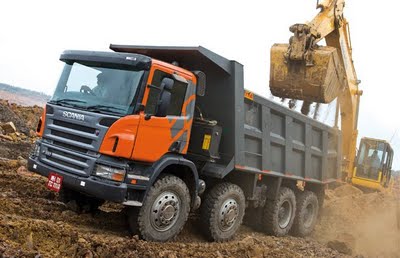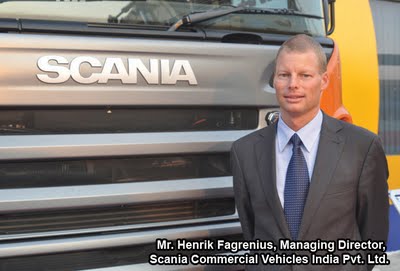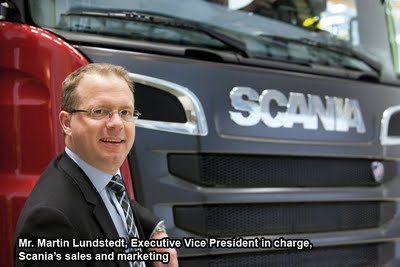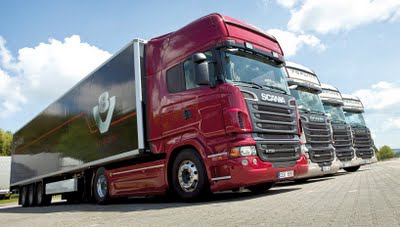 In 2011, Scania completes 100 years of its existence, and the company has taken the important decision to enlarge its presence in the Indian commercial vehicle market.
In 2011, Scania completes 100 years of its existence, and the company has taken the important decision to enlarge its presence in the Indian commercial vehicle market.Scania entered India in 2007 in partnership with Larsen & Toubro (L&T;) for selling its high-end tippers in the Indian mining market. The company currently offers Scania P380, a 380hp tipper truck for mining applications. Till date the company has sold over 600 tipper trucks in India. Currently these trucks are imported as fully-built units with the tipper bodies being sourced locally. After a careful study of the Indian market and the potential it offers for high-performance trucks and buses, Scania has taken the next big step of setting up an Indian entity and also an assembly facility for trucks and buses. Mr. Henrik Fagrenius, Managing Director, Scania Commercial Vehicles India Private Ltd., said: “We’ve had a partnership with L&T; since 2007-08 and they’ve shown us that there are segments in the Indian market where our products and business models are suitable. Therefore we have decided to enter new segments. We will enter the on-road heavy haulage truck segment, the premium Intercity luxury bus and coach segment, the city bus segment and industrial and marine engines. We will establish a Regional Product Center in and around Bangalore”.
Mr. Henrik Fagrenius, Managing Director, Scania Commercial Vehicles India Private Ltd., said: “We’ve had a partnership with L&T; since 2007-08 and they’ve shown us that there are segments in the Indian market where our products and business models are suitable. Therefore we have decided to enter new segments. We will enter the on-road heavy haulage truck segment, the premium Intercity luxury bus and coach segment, the city bus segment and industrial and marine engines. We will establish a Regional Product Center in and around Bangalore”.
Scania India Commercial Vehicles Private Ltd. is a 100 per cent subsidiary company of Scania global. The company was established in February 2011. The exact capital outlay is now known. The new facility is expected to come up on the outskirts of Bangalore. “We hope to have this up and running by next year. We are aiming to do this as quick as possible”. Says Mr. Martin Lundstedt, Executive Vice President in charge of Scania’s sales and marketing: “There is a demand for vehicles and engines of the quality and performance that Scania stands for. Within the next five years, we expect to be able to achieve annual sales of almost 2,000 trucks, 1,000 buses and 1,500 engines”.
Says Mr. Martin Lundstedt, Executive Vice President in charge of Scania’s sales and marketing: “There is a demand for vehicles and engines of the quality and performance that Scania stands for. Within the next five years, we expect to be able to achieve annual sales of almost 2,000 trucks, 1,000 buses and 1,500 engines”.
Sustained economic growth, growing exports, and the expansion of highways and logistic systems are factors behind Scania’s decision to strengthen its presence in the Indian market. “In the longer term, India will be a key market for Scania. We are now taking a new important step into the market, and look forward to growing and developing the business together with our partner L&T;,” concludes Mr. Lundstedt.
Mr. Fagrenius observes: “L&T; will continue to play an important role in relation to Scania’s sales and service in the Indian construction equipment market. Our own presence in the country will also strengthen L&T;’s position, since the company’s Scania customers will benefit from a larger range of models, shorter delivery times and higher service availability.”
L&T; has so far been importing the tipper trucks from Scania as CBUs. With the setting up of the new assembly facility and the Indian entity, Scania will import the trucks and buses as CKDs and assemble it at the Indian facility. This will significantly reduce the lead time for the customer, says Mr. Fagrenius.
During the second half of 2011, Scania will provide a small number of buses and trucks for test operations to select Indian customers in the on-road truck and bus segment. “The potential exists to broaden our existing offer of trucks to the mining industry but also within other areas in the construction segment, as well as trucks for heavy special-purpose road transport. Within the bus segment we see a potential for sales of buses and coaches both for city traffic and long-haul intercity traffic,” he adds.
Scania heavy duty mining tippers were introduced in the Indian market in 2007 together with L&T.; The Indian company has successfully established Scania’s heavy construction trucks in the mining industry, and currently operates about 10 Scania service workshops in various mining sites in the country.
Scania has established similar product centers in Taiwan, Malaysia, Dubai, South Africa, South Korea and Russia, and now in order to show its long-term commitment to the Indian market it is establishing one in India as well. The company is also planning to set up an R&D; centre in India.
Apart from offering the P380 6X4 tipper, Scania is planning to enter the on-road, heavy haulage truck segment, for Over Dimensional Cargo (ODC) transportation. The company is planning to offer a 6X4 Tractor with a power rating of 380 upto 500 hp for ODC transportation. We will put a few test units on road during the current year.
Even in markets like Europe, Scania has positioned its products in the top-end of the market. India will be no different. “Scania trucks and buses ensure high uptime, low fuel consumption and low cost of ownership. We are trying to find segments where our business model is valid and understood by customers”.
Scania will be offering the same global products, trucks and buses in the Indian market. It doesn’t have plans of developing any India’s specific truck or bus to cater to the local market. It might make some adaptations to the existing product to suit local conditions. It is not ruling out the possibility of exporting trucks and buses assembled out of India. In the bus segment, Scania is planning to put some test units on road during the latter part of the current financial year. “It will initially focus on the inter-city luxury buses and later the city buses. The chassis will be CKD, and we are doing a final investigation on how to do the body”. The company is exploring the possibility of either building its own bodies or doing it through an established Indian bus body builder, as per Scania’s quality standards.
In the bus segment, Scania is planning to put some test units on road during the latter part of the current financial year. “It will initially focus on the inter-city luxury buses and later the city buses. The chassis will be CKD, and we are doing a final investigation on how to do the body”. The company is exploring the possibility of either building its own bodies or doing it through an established Indian bus body builder, as per Scania’s quality standards.
In the top-end luxury inter-city bus segment, the market has migrated towards multi-axle buses. Scania might introduce a 6X2 multi-axle bus instead of a 4X2 single-axle bus.
Engines
Scania is a major supplier of engines for industrial and marine applications. The company sold 6,526 units last year. It will offer these engines in the Indian market too. Globally Scania supplies engines to construction equipment manufacturers like Terex and Doosan. The company will explore the possibility of supplying engines to these manufacturers in India and also the genset market. For trucks and buses, Scania manufactures nearly 21 critical parts in-house at its plant in Sweden. Core components like axles, gearbox and engines will all be manufactured by Scania and imported from its global facilities.
For trucks and buses, Scania manufactures nearly 21 critical parts in-house at its plant in Sweden. Core components like axles, gearbox and engines will all be manufactured by Scania and imported from its global facilities.
“We will have 10-15 per cent local content when we start assembly in India. We are already buying Indian tyres and our tipper bodies are made in India”. Mr. Henrik said: “We are focused on the driver. A good driver can help upto 10 to 15% improvement in fuel consumption, which helps in better cost of operations. We do quite an extensive driver training program along with L&T.; We are working with drivers at the customer place and at the working sites, in the mines”.
What differentiates Scania from others in India has been its after-sales service support. “Together with L&T; we have set new standards in service. We have erected mobile workshops at customer sights to be able to assure the customers that the uptime is the best. We are currently a team of 10 and it will be 20 by the year end. Once the facility is up and running, we will have at least a 100 people on board. In the initial stages we will have the Scania global team to put the manufacturing procedures and systems in place”, he added.